Tram Post of Hamburg
0. Foreword
The article describes the story of the tram post in Hamburg (1922 – 1943) for ordinary letters. In this period people were permitted to post their letters into post boxes on the tram cars.In Hamburg the „Reichspost“ (imperial post) used the extensive tram network for postal service. The tram network in Hamburg was in a star configuration at the central railway station.
The purpose of the transportation was a fast supply lead of the letters in the post internal circuit.
Letterboxes on street corners or in post-office buildings were emptied regularly one to three times per day; tram mailboxes nearly every hour. Every box reaching the central points was emptied. The transmission time for letters could be shortened to around one to two days.
A contract was entered between the “Reichspost” and the “HHA” (“Hamburger Hochbahn Aktiengesellschaft” – Hamburg elevated railway corporation) concerning the postal service and was effective from the 1. September 1920. Between the 1. September 1920 and 31. December 1921 only express letters or telegrams were allowed to be sent.
The “HHA” fastened post boxes to the tram cars. Emptying places were located near Hamburg central station.
Because of the success of this postal service ordinary letters were also allowed to be posted; these however required special charges of 75 Pfennig; beginning 1. January 1922.
For telegrams and express letters no special fee was to be paid.
1.1 The “Postpavillon”
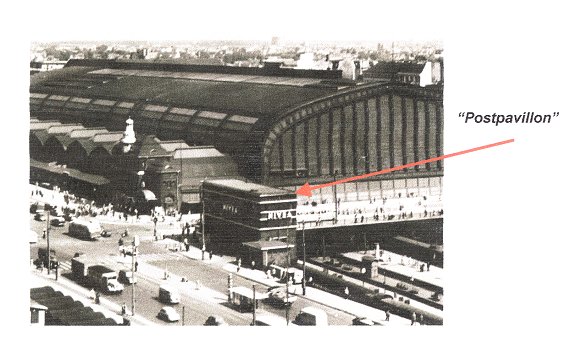
The tram post mail boxes were attached on the trams which crossed the streets “Steintorbrücke”, “Mönckebergstraße” and “Georgsplatz”.
The mail boxes were emptied from 7 a.m. to 11 p.m.. At other times the letter box flap was locked down.
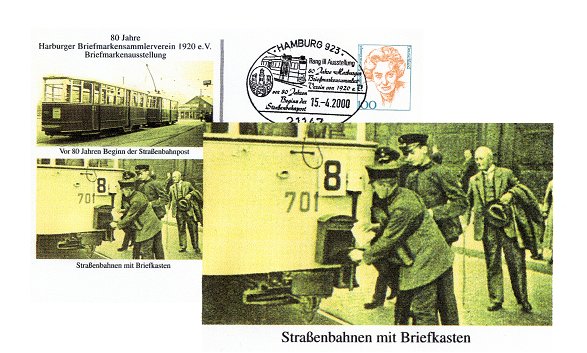
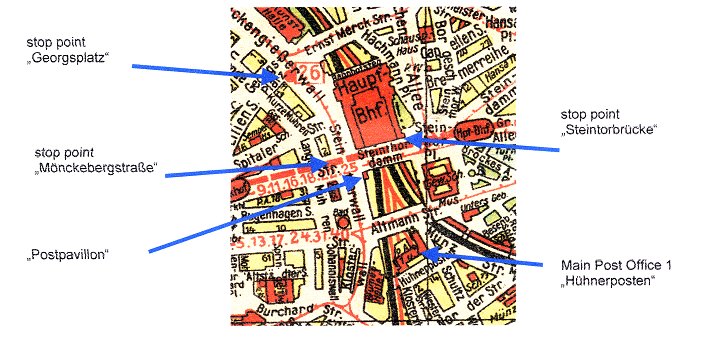
1.2 Main Post Office 1 "Hühnerposten"
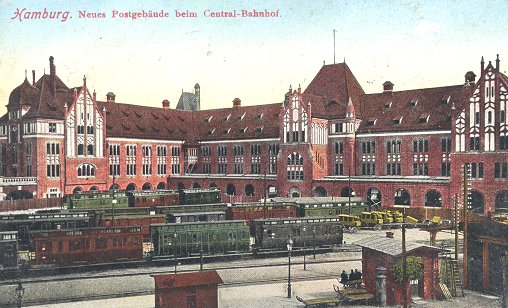
The “Postpavillon” and the Main Post Office 1 were interconnected by a pneumatic mail system. A fast exchange of the mail shipments was ensured.
From the Main Post Office 1 the consignment could travel inter-city-letter directly by railway. The building has direct railway sidings.
1.3 Tram post cancel
Tram post cancel (choice)
| Cancel | Description | Employment time | |
| 1 | 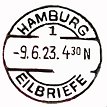 |
ring segment standard cancel → 27 mm „1“ = post office Hamburg 1 ring segment bridge with information: date, time in steps of ten minutes and time of day - V = „Vormittag“ (a.m.); N = „Nachmittag“ (p.m.) The lower ring segment shows: “EILBRIEFE” (express letters) Note: abrasion |
1920 - 1927 |
| 2 | 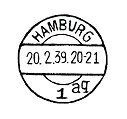 |
ring segment standard cancel → 26 mm ring segment bridge with information: date, time domain. The lower ring segment shows: „1“ = post office Hamburg 1and index number “aq”. |
1923 - 1942 |
| 3 | 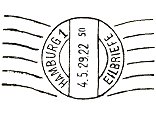 |
handroller stamp → 25 mm „1“ = post office Hamburg 1 ring segment bridge with information: date, time in steps of ten minutes The lower ring segment shows: “EILBRIEFE” (express letters) |
1927 - 1934 |
| 4 | 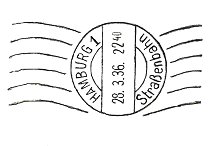 |
handroller stamp → 25 mm „1“ = post office Hamburg 1 ring segment bridge with information: date, time in steps of ten minutes The lower ring segment shows: “Straßenbahn” (tram) |
1931 - 1940 |
| 5 | 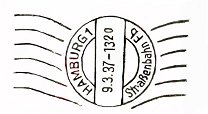 |
handroller stamp → 25 mm „1“ = post office Hamburg 1 ring segment bridge with information: date, time in steps of ten minutes The lower ring segment shows: “Straßenbahn Fb” (tram - department description “Fb”). |
1934 - 1939 |
| 6 | 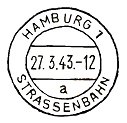 |
standard cancel → 28 mm „1“ = post office Hamburg 1 segment bridge with information: date, time. In step of hoursIndex number “a” The lower ring part shows: “STRASSENBAHN” (tram) |
1934 - 1943 |
| 7 | 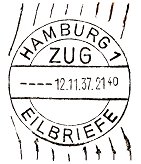 |
handroller stamp → 34 mm „1“ = post office Hamburg 1 „ZUG“ (train) in upper ring segment. Ring segment bridge with information: date, time in steps of ten minutes. Typically the cancel is used for express letter incoming by railways. On route passing cancellation the ring segment bridge shows in addition the railway train number. By using for tram post, the train number are missing. The lower ring segment shows: “EILBRIEFE” (express letters) |
1934 - 1940 |
Tram post rubber supplement cancel (choice)
| A |  |
two line rubber cancel L 2: 43 mm | 1922 - 1924 |
| B |  |
two line rubber cancel L 2: 55 mm | 1924 - 1930 |
| C |  |
two line rubber cancel L 2: 70 mm | 1930 - 1938 |
Insufficient payments for postage received an excess penalty.
In order to avoid misunderstandings with the public the signification of “express letter” was gradually replaced from the stamp “EILBRIEF” (express letter) to “Straßenbahnpost” (tram post). Therefore the rubber stamp “Aus dem Straßenbahnbriefkasten” (“From the tram post box”) had become redundant.
1.4 Rolling stock of the tram
In times of rush hour the trams run with motor coach and trailer vehicle. The mail boxes were always attached at the end of a tram. If the motor coach ran alone at weekends, then this carried the mail box.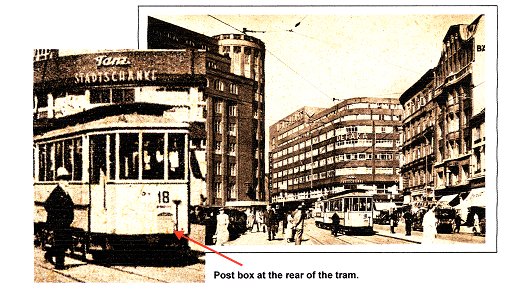
To beginning with the fleet of tram cars consisted of 2-axle based steel rack and wooden car bodies. In 1927 a larger 4-axle vehicles came into use and from 1935 a newer version in completely steel.
2.0 Changes of the special charge in the time of hyperinflation
(1. January 1922 – 30. November 1923)
The political situation enforced the introduction of these special charges.With the start of postal service for ordinary letters special charges of 75 Pfennigs per letter were levied. The special charges were changed 18 times before 26. November 1923. They rose in the time of hyperinflation to 5 billion marks on the 1. December 1923.
All letters out of the tram post boxes were given a postmark like this “aus dem Straßenbahnbriefkasten” (out of the tram post box) registering the special charges (see 1.3 Tram post cancel). Then it was checked whether additional fee was covered by the postage stamps.
If the payment was not enough an excess postage was charged. The excess postage was written by hand with blue crayon on the letter. The receiver of the letter had to pay the excess postage. Incorrectly paid letters were charged double the difference to the regular price until 27. February 1923 and from the 1. March 1923 they were charged 1 ½ times the difference.
Mail rate period 1. October 1922 – 14. November 1922: 100 Pfennigs special charges
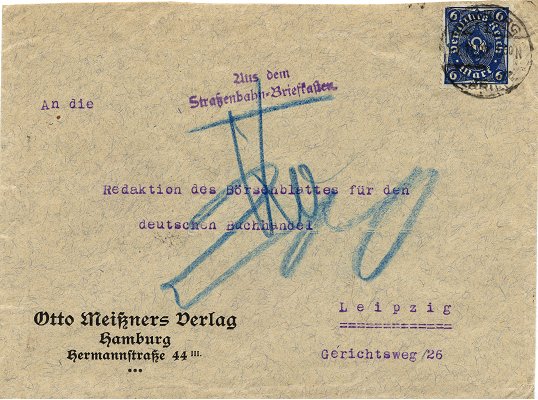
Paying 6,00 Marks. The letter is with 1,00 Mark incorrectly paid.
Surcharge: 200 Pfennigs. The excess postage signed with a blue crayon „200“ for 200 Pfennigs. Surcharge regulation double the difference to the regular price.
Trampost postmarks: ring segment standard cancel → 27 mm “EILBRIEFE” (Cancel 1) and L 2 „Aus dem / Straßenbahn=Briefkasten“ (rubber supplement cancel A).
Mail rate period 15. December 1922 – 14. January 1923: 400 Pfennigs special charges
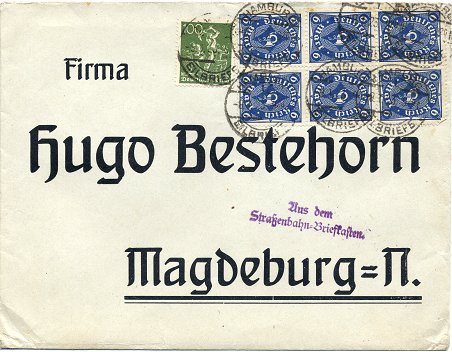
Trampost postmarks: ring segment standard cancel → 27 mm “EILBRIEFE” (Cancel 1); L 2 „Aus dem / Straßenbahn=Briefkasten“ (rubber supplement cancel A).
Mail rate period 24. August 1923 – 31. August 1923: 1,000 Marks special charges
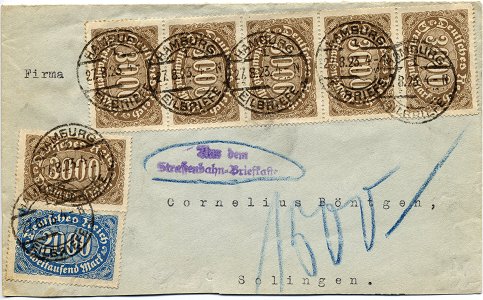
Trampost postmark: ring segment standard cancel → 27 mm “EILBRIEFE” (Cancel 1); L 2 „Aus dem / Straßenbahn=Briefkasten“ (rubber supplement cancel A).
Mail rate period 5. November 1923 – 11. November 1923: 50 million Marks special charges
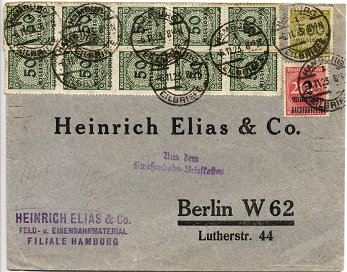
Trampost postmark: ring segment standard cancel → 27 mm “EILBRIEFE” (Cancel 1); L 2 „Aus dem / Straßenbahn=Briefkasten“ (rubber supplement cancel A).
3. Constant special charges – 5 Pfennigs (1. December 1923 – 1. July 1943)
The German Reich undertake a currency reform. With the introduction of the “Rentenmark” on 1. December 1923 a special charge of 5 Pfennigs was fixed on all forms of tram post. Exceptions were express letters. Airmail was a non-uniform official use. Airmail was usually allowed without special charges like express letters. In this postage class the price of tram postage was included. In the case of airmail it was common that many items carried no special charges.3.1 Postcards
Mail rate period 1. January 1925 – 31. July 1927 (Postcard paying rate 5 Pfennigs)
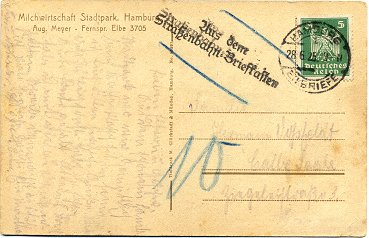
Trampost postmark: ring segment standard cancel → 27 mm “EILBRIEFE” (Cancel 1); L 2 „Aus dem / Straßenbahn=Briefkasten“ (rubber supplement cancel B).
Mail rate period 1. August 1927 – 14. January 1932 (Postcard paying rate 8 Pfennigs)
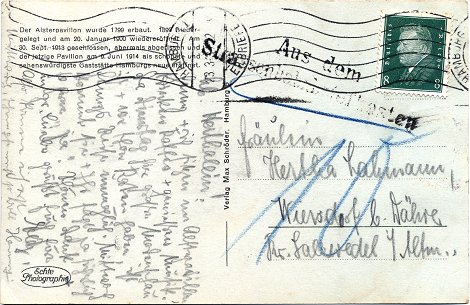
Trampost postmark: handroller stamp with ring segment standard cancel → 25 mm “EILBRIEFE” (Cancel 3); L 2 „Aus dem / Straßenbahnbriefkasten“ (rubber supplement cancel C).
Mail rate period 1. December 1933 – 14. May 1938 (Postcard paying rate 6 Pfennigs)
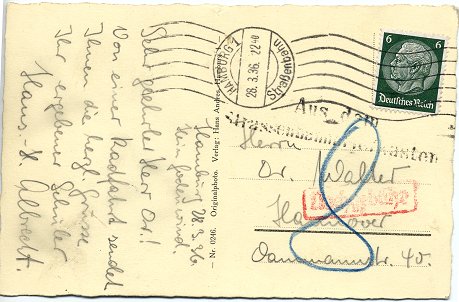
Trampost postmark: handroller stamp with ring segment standard cancel → 25 mm “Straßenbahn” (Cancel 4); L 2 „Aus dem / Straßenbahnbriefkasten“ (rubber supplement cancel C); supplement cancel: “Nachgebühr” (surcharge).
Mail rate period 1. December 1933 – 14. May 1938 (Postcard paying rate 6 Pfennigs)
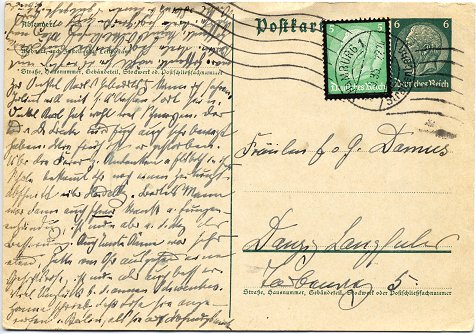
Trampost postmark: handroller stamp with ring segment standard cancel → 25 mm “Straßenbahn” (Cancel 4)
Note: German stamps featuring President Paul von Hindenburg. When von Hindenburg died they printed a black border on the stamps.
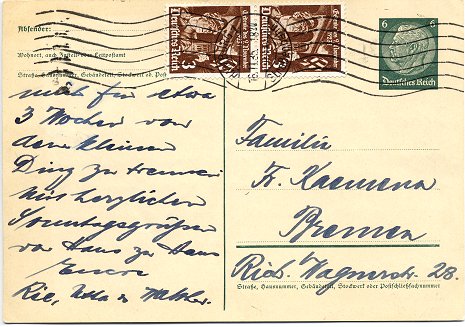
Trampost postmark: handroller stamp with ring segment standard cancel → 25 mm “Straßenbahn” (Cancel 4)
Note: Stamps as instruments of Nazi propaganda.
3.2 Standard letter for up to 20 grams
Mail rate period 1. December 1933 – 14. May 1938
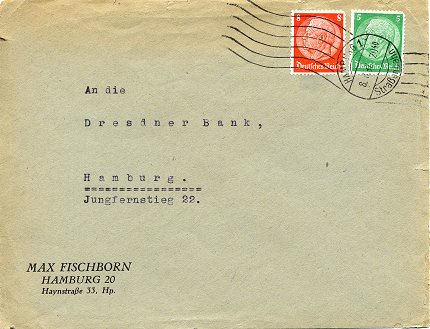
Trampost postmark: handroller stamp with ring segment standard cancel → 25 mm “Straßenbahn” (Cancel 4)
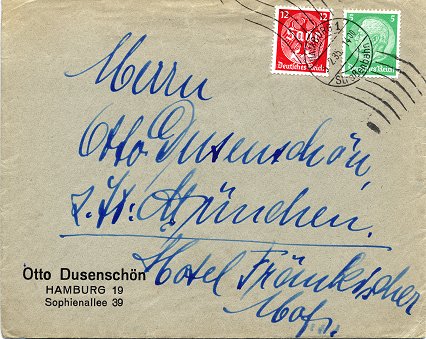
Trampost postmark: handroller stamp with ring segment standard cancel → 25 mm “Straßenbahn” (Cancel 4)
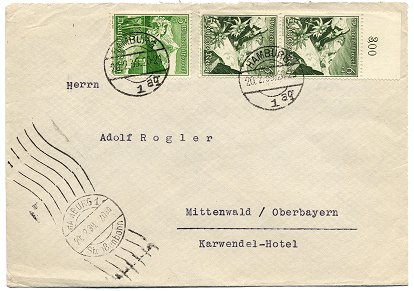
3.3 Express delivery
Mail rate period as from 1. August 1927
City delivery area (“Ortszustellung”) rate 40 Pfennigs; overland delivery area (“Landbestellbezirk”) rate 80 Pfennigs. In these postage class the price of tram postage was included.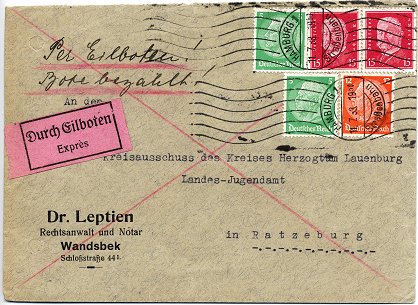
Trampost postmark: handroller stamp with ring segment standard cancel → 25 mm “Straßenbahn” (Cancel 4)
Note: hand made red crayon cross for post internal information: this is an Express letter. Express label.
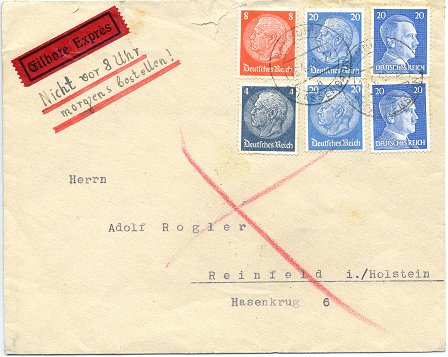
Trampost postmark: segment standard cancel → 28 mm “STRASSENBAHN” (Cancel 6)
Note: hand made red crayon cross for post internal information: this is an Express letter. Express label.
3.4 Posted to foreign countries
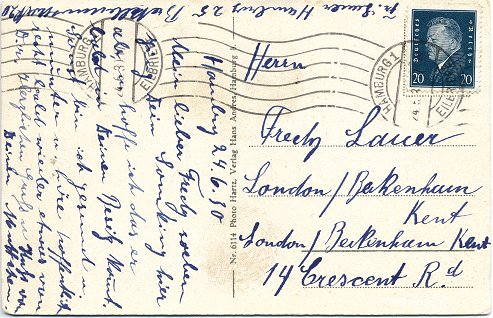
Trampost postmark: handroller stamp with ring segment standard cancel → 25 mm “EILBRIEFE” (Cancel 3).
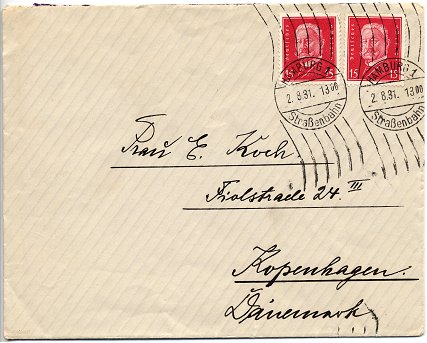
Trampost postmark: handroller stamp with ring segment standard cancel → 25 mm “Straßenbahn” (Cancel 4)
3.4.1 Express letters to foreign countries.
The express delivery rate to foreign countries is 50 Pfennigs. In this postage class the price of tram postage was included.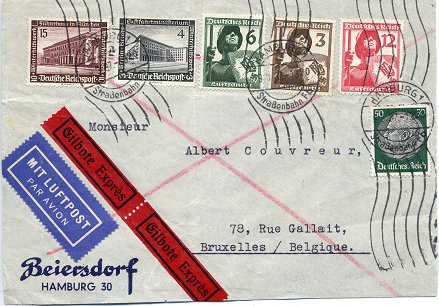
Trampost postmark: handroller stamp with ring segment standard cancel → 25 mm “Straßenbahn Fb” (Cancel 5)
Note: hand made red crayon cross for post internal information: this is an Express letter. Express label.
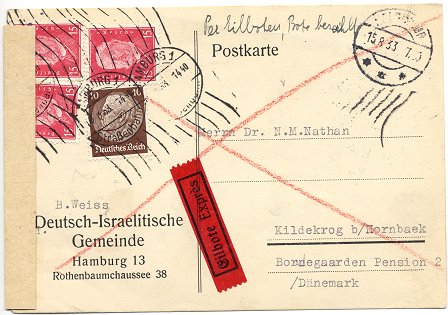
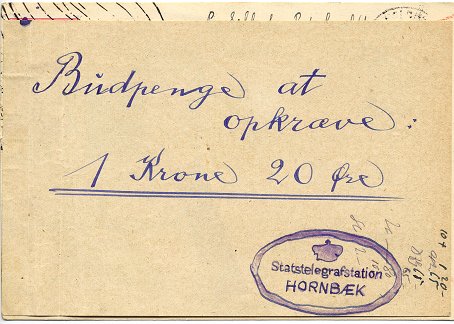
Trampost postmark: handroller stamp with ring segment standard cancel → 25 mm “Straßenbahn” (Cancel 4)
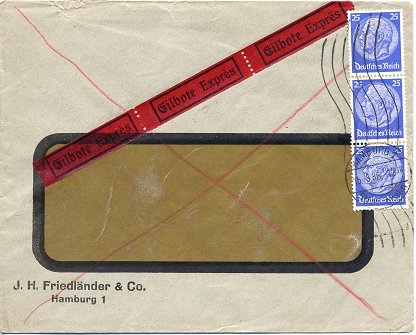
Trampost postmark: handroller stamp with ring segment standard cancel → 25 mm “Straßenbahn” (Cancel 4)
Note: hand made red crayon cross for post internal information: this is an Express letter. Express labels.
3.4.2 Express letter to occupied countries – for example: Bohemia and Moravia
Effective from 30. November 1940 geographical limits of the inland mail charges were expanded to the occupied countries.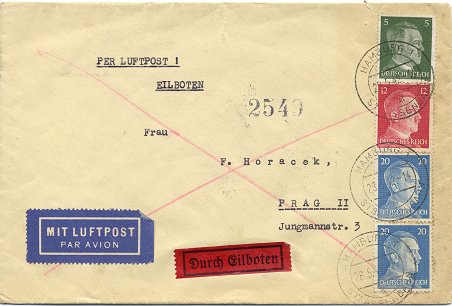
Trampost postmark: segment standard cancel → 28 mm “STRASSENBAHN” (Cancel 6)
Note: hand made red crayon cross for post internal information: this is an Express letter. Express and airmail label.
3.4.3 Foreign airmail letters
Examples of the difference with and without special charge of 5 Pfennigs for tram post.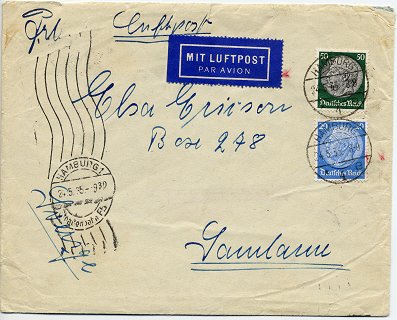
Trampost postmark: handroller stamp with ring segment standard cancel → 25 mm “Straßenbahn Fb” (Cancel 5)
Note: Airmail label.
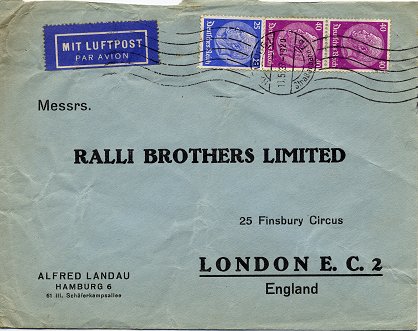
Trampost postmark: handroller stamp with ring segment standard cancel → 25 mm “Straßenbahn Fb” (Cancel 5)
Note: Airmail label.
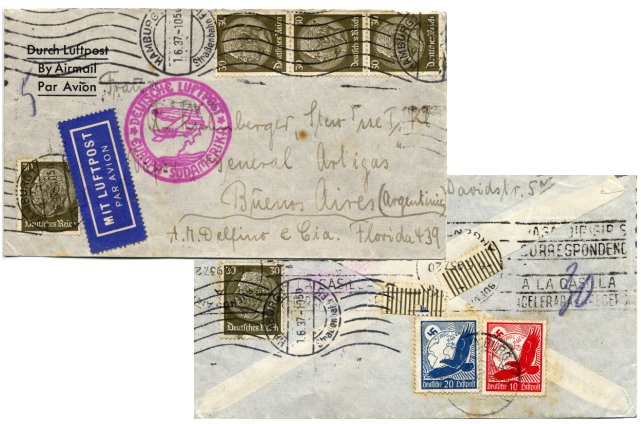
Trampost postmark: handroller stamp with ring segment standard cancel → 25 mm “Straßenbahn Fb” (Cancel 5)
Note: The weight is signed with black crayon “5” for 5 grams. Airmail label. A red conformation postmark „DEUTSCHE LUFTPOST * EUROPA – SÜDAMERIKA *“ (German Airmail – Europe - South America. (30 Pfennigs is stuck on back side).
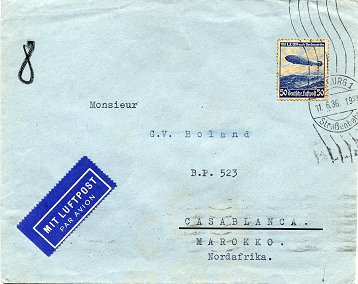
Trampost postmark: handroller stamp with ring segment standard cancel → 25 mm “Straßenbahn” (Cancel 4)
Note: Airmail label.
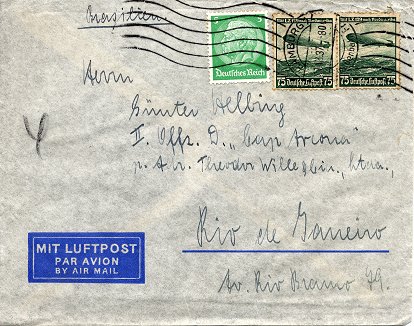
Trampost postmark: handroller stamp with ring segment standard cancel → 25 mm “Straßenbahn Fb” (Cancel 5)
Note: Airmail envelope with printed airmail label.
3.5 Army postal service
Fieldpost letter which took the special trampost service had to carry the regular charges of 5 Pfennigs.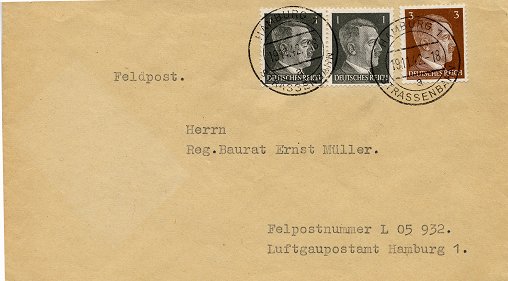
Trampost postmark: segment standard cancel → 28 mm “STRASSENBAHN” (Cancel 6)
3.6 The end of the tram post 1943
The war came to Germany. The whole infrastructure destroyed by air raid in July and August 1943 in Hamburg (Operation Gomorra). After the bomb attacks the tram division of postal service was terminated (last date 24. July 1943).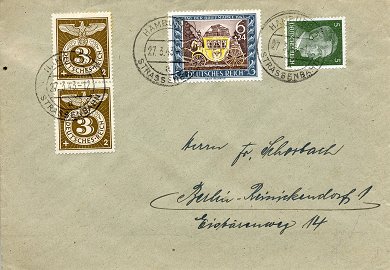
Trampost postmark: segment standard cancel → 28 mm “STRASSENBAHN” (Cancel 6).
4.0 Tram Post between 1949 and 1958
For a short period between the 1. August 1949 and 31. March 1958 the tram post was reintroduced. In this period no special fee was charged. With the increase of telephone and teleprinter usage this public network service was no longer necessary.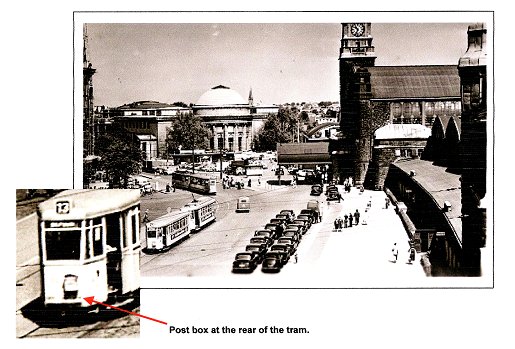
5.0 Summary
My special gratitude is for Harald Krieg and Thomas Kahlbom (authors of numerous publications over tram post and other posthistoric topics) who have repeatedly helped me with the draft of my own collection and for Steve Riley who has patiently corrected my English mistakes from the manuscript.6.0 References
| /1/ | Schwaneberger Verlag Hrsg.: | Michel, Postgebühren-Handbuch Deutschland, München 2001 |
| /2/ | Kahlborn, Thomas u. Krieg, Harald: | Straßenbahnpost in Hamburg, Sonderdruck Harburger Briefmarkensammler-Verein v. 1920 e.V.; Hamburg April 2000 |
| /3/ | Erich Kulmann: | Post und Straßenbahn in Hamburg; in Postgeschichtliche Blätter Hamburg, Heft 21, 1978 |
| /4/ | Kahlborn, Thomas u. Krieg, Harald: | Postbeförderung mit der Hamburger Straßenbahn, Hamburg 2005 |
| /5/ | All pictures, cancels and letters are examples of my collection. |
